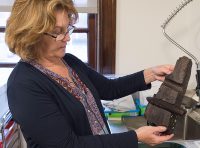 The 19th century ship’s hull that washed up on Florida’s Ponte Vedra Beach on March 28th continues to prove how unusual it is. Environmental archaeologist Lee Newsom took samples of the hull and examined them under the microscope, the first laboratory analysis of the shipwreck’s wood. Her examination found that it is predominantly American Beech (Fagus grandifolia), a tree native to the Eastern and Southern United States.
The 19th century ship’s hull that washed up on Florida’s Ponte Vedra Beach on March 28th continues to prove how unusual it is. Environmental archaeologist Lee Newsom took samples of the hull and examined them under the microscope, the first laboratory analysis of the shipwreck’s wood. Her examination found that it is predominantly American Beech (Fagus grandifolia), a tree native to the Eastern and Southern United States.
“I rarely ever see that,” she said. “So it was a surprise to see that instead of oak.”
She said oak is what ships are usually made of.
“So maybe the usual oak was not available for one reason or another. So whoever constructed this ship shifted to beech,” Newsom said.
The wood is also cut from the tree trunk in different ways, which leads her to ask, “Were the larger trees no longer available? So you shift to this? It means timber was in short supply.”
Newsom said the wood is in fantastic condition, so it’s revealing even more.
“That’s telling me, this whole section has been buried under the sediment since it wrecked probably,” Newsom noted.
Except for the weeks it spent on the beach getting cooked by the Florida sun. Archaeologists were concerned about the condition of the wood before it was removed from its exposed position, so it’s great news that they managed to keep it wet enough to preserve it on a cellular level for analysis.
Preliminary visual examination noted the presence of both hardwood and softwood. Ships are typically made of hardwoods for durability, and the combination suggested it may have been constructed by a small shipwright in the South where softwood is more abundant and less expensive. Beech is a hardwood, but it is found in South and the type of cuts indicate cost was a factor, so the hypothesis still stands.
Possible origins of the wood include Georgia, the Carolinas and the Gulf Coast. Additional analysis will have be done to make a more precise determination, and it may never be narrowed down to a single location, nevermind to where the ship was built. Newsom will continue her research and, as a granddaughter of a shipwright, hopes against hope that she’ll be able to identify the builder. It’s not very likely, however.